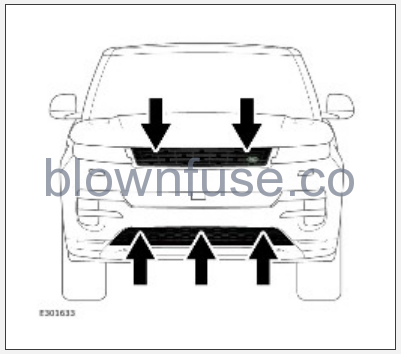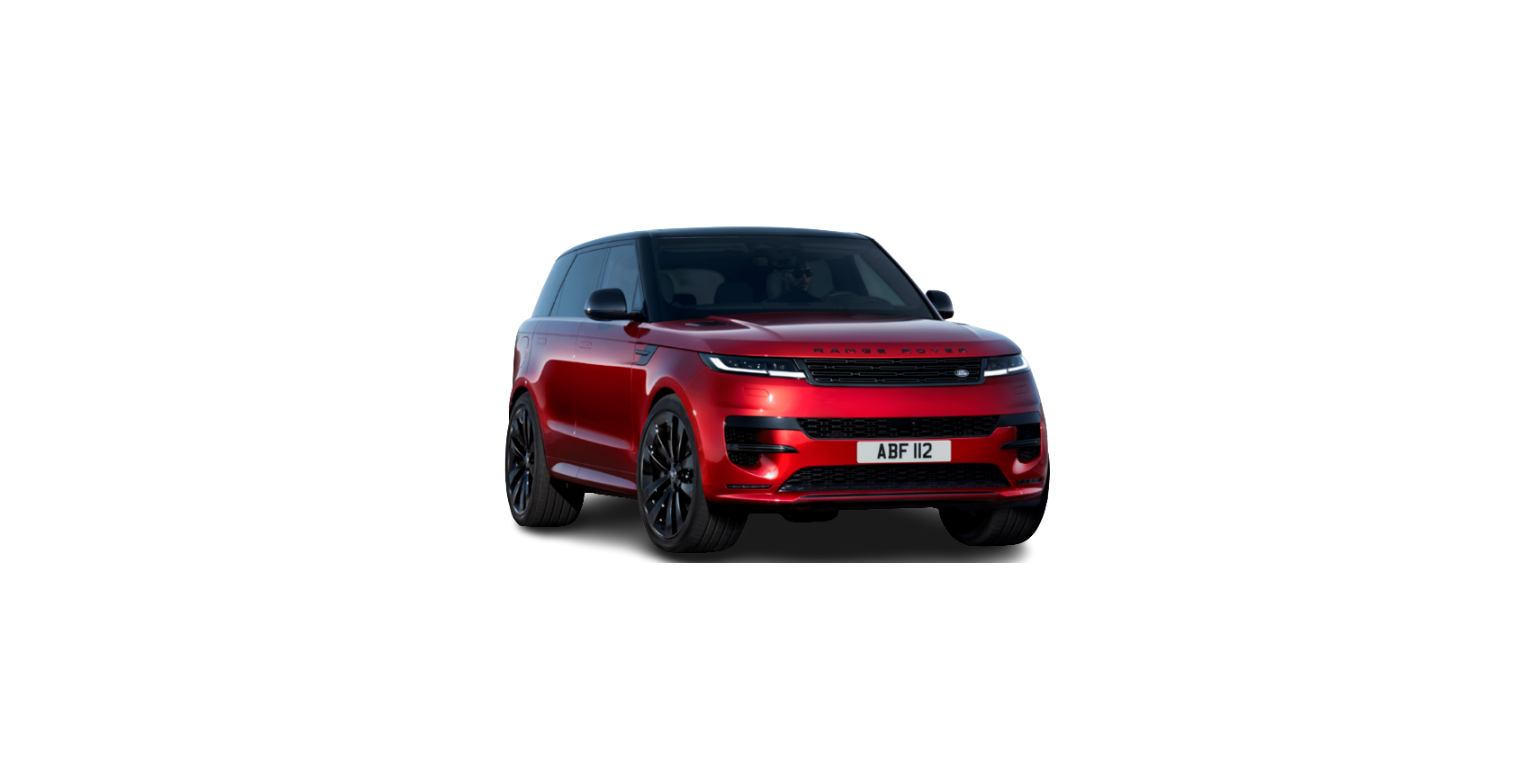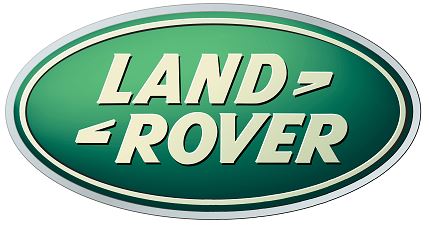2023 Land Rover New Range Rover Sport Vehicle Cleaning

THE EXTERIOR
Make sure the tailpipe is cool before polishing the tailpipe finishers. Failure to do so may result in personal injury.
- To prevent damage to the vehicle when using a detailing service, make sure to advise them of the cleaning instructions contained within the Owner’s Handbook.
- Following cleaning of the vehicle’s exterior, it is recommended that the vehicle is taken for a short drive, in order to dry out the brakes. A short drive, in order to dry out the brakes, is especially recommended if a pressure washer is used. Wet brakes may impair the vehicle’s ability to safely slow down which may result in damage to the vehicle.
- Remove any heavy deposits of mud and dirt with a hose, before washing the vehicle.
- Some high-pressure cleaning systems are sufficiently powerful to penetrate door and window seals, and damage trim, door locks and door handles. Never aim the water jet directly at the engine air intake, heater air intakes, radiator cooling fins, body seals, cameras, or at any components which may be damaged.
- Do not use a power wash system in the engine bay area, or directed at door handles, as it may cause damage.
- Make sure to read and comply with all warnings and product instructions supplied with any cleaning products.
- Never use cleaning products that are not approved for use on vehicles. Using unapproved cleaning products may cause damage to the vehicle.
- Substances that are corrosive, such as bird droppings, can damage the vehicle’s paintwork and should be removed as soon as possible.
To avoid damage to the hood, do not lift the wipers when they are in the normal parked position. See WIPERS SERVICE POSITION.
After washing the vehicle, it is recommended to use a suitable metal polish on stainless steel or chrome finishers to restore the surface appearance.
Do not aim the water jet directly at any rubber gaiters or seals on suspension joints.
Make sure that the water jet nozzle is more than 12 in (300 mm) away from vehicle components.
- The vehicle manufacturer recommends the use of specialized satin paint products when cleaning the vehicle’s exterior. Any other cleaning or paint protection product may have an adverse effect on the paint finish.
- Never polish vehicles that have a satin matte paint finish. Polishing causes the finish to shine and may reduce the matte effect.
- Do not use an automated car wash. Using unapproved cleaning equipment can cause damage to the vehicle’s exterior.
- Stickers, films, magnetic plates, or similar should not be affixed to the vehicle’s exterior. Removing such objects can cause damage to the vehicle’s paint work.
Additional care is required when cleaning the exterior of vehicles with a satin matte paint finish. It is recommended to wash the vehicle by hand, using a soft sponge, making sure not to apply high pressure to the paint surface. Avoid washing the vehicle in direct sunlight.
Remove any of the following substances immediately, where possible:
- Insect remains.
- Bird droppings.
- Fingerprints.
- Tree resin.
- Oils, grease, and fuels.
- Wax.
- Tar spots.
SENSORS AND CAMERAS
When washing the vehicle, do not aim high-pressure water jets directly at any of the sensors and cameras. High-pressure water jets may damage the sensors and cameras.
Do not use abrasive materials, or hard or sharp objects, to clean the sensors and cameras. Such objects may cause damage to the vehicle’s sensors and cameras.
Only use approved vehicle shampoo. Using unapproved cleaning products may damage the vehicle.
Keep the parking sensors clean to maintain accuracy and performance.
If required, clean the cameras using a cloth moistened with a small amount of glass-cleaning product.
USING AN AUTOMATIC WASH
Commercially operated, automatic car washes, jet washes, and power-operated mops are not recommended. Using such cleaning equipment can cause damage to the vehicle.
ENGINE COMPARTMENT
The high voltage system has no serviceable parts. Never disassemble, remove, or replace high voltage components, cables, or connectors. Tampering with the high voltage system can cause severe burns or electric shock, which may result in serious injury or death. High voltage cables and connectors are colored orange for identification purposes. If maintenance or repair is required, always consult a retailer/authorized repairer.
Do not use a high-pressure washer or steam cleaner in the engine compartment. Pressure washing has the potential to cause damage to certain engine components.
Pressure washing has the potential to damage high voltage electrical components and cables.
Make sure that the brake fluid reservoir is kept dry at all times. Only use a clean, dry cloth to clean the brake fluid cap and reservoir. Not doing so can cause damage to the vehicle.
AFTER OFF-ROAD DRIVING

Make sure the vehicle’s underside is cleaned as soon as possible after driving off-road.
Make sure that the areas indicated around air intakes and the front grille are clean and clear of debris. Pay particular attention to the lower grille, radiator pack, intercoolers and brake ducts. Failure to do so may cause the engine and/or brakes to overheat, potentially leading to engine and/or brakes damage.
For vehicles fitted with air suspension, raise the suspension to Off-Road 2 to improve cleaning access. See OFF-ROAD HEIGHT.
Make sure all mud and debris is removed from the rear air spring. Failure to do so may lead to permanent damage to the air spring sleeve.
Make sure that the pressure washer nozzle is always at a distance of at least 19.7 inches (500 mm) from the face of the radiator pack to prevent damage.
To clean the radiator pack, intercoolers and brake ducts through the bumper apertures, the pressure washer nozzle must be at a distance of at least 7.9 inches (200 mm) from the openings.
To improve aerodynamics, some vehicles are fitted with Active Grille Shutters for both radiator pack as well as air duct for brake disc cooling. The shutters open when engine needs cooling or Air Conditioning (A/C) is switched on or brake discs need cooling. The shutters must be opened manually to allow access to any debris from the radiator pack and the brake ducts after off-road driving.
- Start the engine. Allow the engine to run for a few seconds. See STARTING THE ENGINE.
- Switch the engine off.
- Switch the ignition on. See SWITCHING ON THE IGNITION.
- Select mud and ruts mode on the terrain response system. See TERRAIN RESPONSE OPERATION.
- Switch the engine off.
Make sure that the areas around the wheel and brake assemblies are clean and clear of debris. Inspect the wheel rims for signs of damage or scoring, and check for unusual brake noise when driving and applying the brakes.
ALLOY WHEELS
Only use appropriate wheel cleaning products for alloy wheels. Using inappropriate cleaning products or failing to follow the manufacturer’s application guidelines may cause damage to the component or the vehicle.
GLASS SURFACES
Clean the rear window with a soft cloth to avoid damaging the heating element. Do not scrape the glass or use any abrasive cleaning fluid.
Mirror glass is particularly susceptible to damage. Wash with soapy water. Do not use abrasive cleaning compounds or metal scrapers to remove ice.
To avoid damaging the protective coating, only clean the interior side of the sunroof glass with a soft cloth. Do not scrape the glass or use abrasive cleaning fluids.
REAR SCREEN
To avoid damaging the heating elements when cleaning the inside of the rear window, use only a soft, damp cloth or chamois leather. Do not use solvents or sharp objects to clean the glass.
SUNROOF WIND DEFLECTOR
A mild solution of soap and water, or car shampoo, should be used to clean the wind deflector net periodically. Support the underside of the net with a soft cloth, and gently scrub the net using a soft-bristled brush.
REMOVING GREASE AND TAR
Remove grease or tar with vehicle manufacturer-approved tar remover or methylated spirit (alcohol). White spirit is also effective, but must not be applied to rubber, particularly the windshield wiper blades.
Make sure that after using methylated or white spirit, the area is washed immediately with soapy water, to remove all traces of spirit. Not doing so may cause damage to the vehicle.
POLISHING
Chrome polish, or other abrasive cleaners, must not be used on the vehicle’s brightwork. Such products may cause permanent damage to the brightwork.
It is recommended that the vehicle is polished regularly using the vehicle manufacturer’s polish and a polishing cloth.
THE INTERIOR
Some cleaning products contain substances that are harmful and can cause health problems if used incorrectly.
- Some cleaning products may cause damage to the vehicle’s interior. Make sure to read the cleaning product’s instructions carefully. If in any doubt as to which products to use, consult a retailer/authorized repairer.
- Do not use chemical agents, solvents, or domestic cleaning products. Using unapproved cleaning products may damage the vehicle.
- To prevent damage to the vehicle when using a detailing service, make sure to advise of the cleaning instructions contained within the Owner’s Handbook.
- Unless spillages, such as tea, coffee, or ink, are washed away immediately, permanent staining may have to be accepted.
- When cleaning, do not allow sharp or abrasive objects to make contact with the components. Sharp or abrasive objects may damage the components.
- Use a soft, dry, lint-free cloth when cleaning switches or controls. Do not apply excessive pressure when doing so. Excessive pressure can damage vehicle components.
- Do not spray liquids directly onto the surface of switches and controls. Fluids leaking into the gaps around switches and controls can damage the electronics of the vehicle.
- Take care when cleaning high gloss surfaces as they are prone to scratching. It is recommended to use a clean micro-fiber cloth in small circular motions, making sure a fresh section of clean cloth is used regularly.
To prevent ingrained dirt and staining, inspect the interior regularly and clean every 1 to 2 months.
It is recommended to vacuum interior surfaces with a soft brush head attachment before using cleaning products.
CLEANING SWITCHES AND CONTROLS
- Use a soft, dry, lint-free cloth when cleaning switches or controls. Do not apply excessive pressure when doing so. Excessive pressure could cause a component malfunction or even lead to a complete failure.
- Vehicles with ceramic switches and controls: If cleaning with a soft, dry, lint-free cloth fails to remove marks or staining, use an appropriate stain eraser suitable for dry cleaning of ceramic tiles. Failure to follow the manufacturers application guidelines may cause damage to the component or even lead to a complete failure.
- Do not spray liquids directly onto the surface of switches and controls. Liquids leaking into the gaps around switches and controls can damage the electronics of the vehicle.
- Do not use chemical agents, solvents, or domestic cleaning products. Using unapproved cleaning products may damage the vehicle.
- When cleaning, do not allow sharp or abrasive objects to make contact with the components. Sharp or abrasive objects may damage the components.
FABRIC UPHOLSTERY
Never use soap, ammonia, bleach, or other cleaners intended for use on hard surfaces. Using unapproved cleaning products may damage the upholstery fabrics.
Do not use upholstery cleaner on electrical equipment such as dashboard switches. Doing so may damage the electrical equipment.
Some materials and fabrics are prone to dye transfer from colored clothing e.g., jeans, which can cause unsightly discoloration of lighter colored materials and fabrics. Affected areas should be cleaned as soon as possible.
Most stains on fabrics can be removed if treatment is carried out immediately before the stain has a chance to dry in. Specific products for use on interior fabrics are recommended for cleaning fabric upholstery, however, dry cleaning fluid or clean water can also be used.
To clean fabric upholstery:
- Wipe with a clean, soft, lint-free cloth or vacuum up the majority of the debris.
- Follow the instructions for the chosen upholstery cleaning product. Avoid over-wetting.
- If staining persists, agitate the surface with a firm sponge or soft brush containing the chosen cleaning product. Dry the surface by wiping with a clean micro-fibre cloth.
To avoid watermarks clean the entire section of fabric containing the stain.
LEATHER UPHOLSTERY
Only use cleaning products specifically designed for use on leather. Do not use chemical, alcohol, or abrasive materials, as doing so will cause rapid deterioration of the leather. The use of non-approved products will invalidate the warranty.
If in any doubt as to which products to use, consult a retailer/authorized repairer. Using the wrong product can cause damage to the leather surfaces.
Dark clothing may stain leather seats, just like other upholstery products.
Sharp objects, such as belts, zippers, rivets, etc., can leave permanent scratches and scratch marks on the leather surface.
To prevent ingrained dirt and staining clean the seat upholstery every 1 to 2 months, dealing with stains immediately.
To clean leather upholstery:
- Wipe off fine dust from the seat surfaces using a clean, damp, non-colored cloth or vacuum with soft brush head attachment. Avoid over-wetting the leather.
- If this is not sufficient, use a cloth which has been dampened with warm, soapy water and then wrung out. Use only mild, non-caustic soap. Alternatively, use an interior upholstery wipe.
- Use the vehicle manufacturer’s leather cleaner for heavily soiled areas. Dry off and rub with a clean, soft cloth. Make sure to change the cloth surface regularly.
Use the vehicle manufacturer’s leather cleaner several times a year to maintain the leather’s suppleness and appearance. The cleaner nourishes and moisturizes the leather, and helps to improve the surface’s protective film against dust and substances.
LEATHER UPHOLSTERY
- Only use cleaning products specifically designed for use on leather. Do not use chemical, alcohol, or abrasive materials, as doing so will cause rapid deterioration of the leather. The use of non-approved products will invalidate the warranty.
- If in any doubt as to which products to use, consult a retailer/authorized repairer. Using the wrong product can cause damage to the leather surfaces.
- Dark clothing may stain leather seats, just like other upholstery products.
- Sharp objects, such as belts, zippers, rivets, etc., can leave permanent scratches and scratch marks on the leather surface.
To prevent ingrained dirt and staining clean the seat upholstery every 1 to 2 months, dealing with stains immediately.
To clean leather upholstery:
- Wipe off fine dust from the seat surfaces using a clean, damp, non-colored cloth or vacuum with a soft brush head attachment. Avoid over-wetting the leather.
- If this is not sufficient, use a cloth that has been dampened with warm, soapy water and then wrung out. Use only mild, non-caustic soap. Alternatively, use an interior upholstery wipe.
- Use the vehicle manufacturer’s leather cleaner for heavily soiled areas. Dry off and rub with a clean, soft cloth. Make sure to change the cloth surface regularly.
Use the vehicle manufacturer’s leather cleaner several times a year to maintain the leather’s suppleness and appearance. The cleaner nourishes and moisturizes the leather, and helps to improve the surface’s protective film against dust and substances.
SEAT BELTS
Do not allow any water, cleaning products, or fabric from cloths to enter the seat belt mechanism. Any substance which enters the mechanism may affect the performance of the seat belt in an impact. Damage to the seat belt can greatly reduce its effectiveness in reducing the risk of serious injury or death in the event of an accident.
Extend the seat belts fully. Specific products for use on interior fabrics are recommended, follow the product instructions. Alternatively, use warm water and a non-detergent soap to clean. Allow the seat belts to dry naturally while fully extended.
While cleaning the seat belt, take the opportunity to examine the webbing for damage/wear. Any wear or damage should be reported to, and rectified by a retailer/authorized repairer.
AIRBAG MODULE COVERS
Air bag covers should be cleaned using only a slightly dampened cloth and a small amount of upholstery cleaner. Some cleaning products may cause damage to air bag covers and air bags which can lead to serious injury or death in the event of an accident.
Do not allow the airbag covers, or surrounding areas, to become contaminated with liquids. Any substance which enters the mechanism can prevent correct deployment of an air bag during an impact and may cause serious injury or death.
CARPET AND MATS
Correctly secure the floor mats before driving. Never place mats on top of each other. Unsecured or incorrectly positioned mats can obstruct the brake and/or accelerator pedal, which can result in accidents, potentially causing serious injury or death.
Marks or stains can be removed by gentle scrubbing with a weak solution of soap and warm water.
For more stubborn stains, a commercially available carpet cleaner should be used.
STEERING WHEEL
Only use cleaning products that are suitable for use on steering wheels and do not produce a slippery surface. A slippery surface could cause a loss of control of the vehicle, potentially resulting in serious injury or death.
CLEANING SCREENS AND DISPLAYS
Do not polish the instrument panel. Polished surfaces are reflective, and may interfere with the driver’s view. Driving without a clean view may lead to a collision, resulting in serious injury or death.
Do not use fluids on electrical equipment such as switches and screens. Fluids can leak into any gaps around the components or between panels or trim and cause damage to components.
Do not use upholstery cleaner on electrical equipment such as dashboard switches. Using unapproved cleaning products can cause damage to electrical equipment.
Observe the following points when cleaning screens and displays:
- To avoid unwanted activation, clean the display while it is switched off.
- Clean with a soft, dry cloth.
- Do not use chemical agents or domestic cleaners.
- Do not allow sharp, hard, or abrasive objects to make contact with screens.
- Avoid exposing screens to direct sunlight for long periods.
- To prevent errors from occurring, make sure only one finger at a time is in contact with the touchscreen.
- Do not use excessive pressure.
WIPER BLADES
To avoid damage to the wiper blade, do not lift the wiper by the wiper blade. Always lift the wiper by the wiper arm. Not doing so may result in damage to the wiper blade.
Do not use excessive pressure. Excessive pressure on the wiper blades can damage the blades. Heavy contamination on the wiper blades should be removed, using a soft, damp sponge or cloth.
BLOCKED WASHER JETS
Do not operate the washer jets during unblocking or adjustment. Windshield washer fluid may cause irritation to the eyes and skin. Always read and observe the washer fluid manufacturer’s instructions.
If a washer jet becomes blocked, use a thin strand of wire to unblock the jet, by inserting the wire into the jet. Make sure the wire is completely removed after unblocking.
REPAIRING MINOR PAINT DAMAGE
Regularly inspect the paintwork for damage. Any stone chips, fractures, or deep scratches in the paint/bodywork should be repaired promptly. Bare metal corrodes quickly, and, if left untreated can result in expensive repairs.

